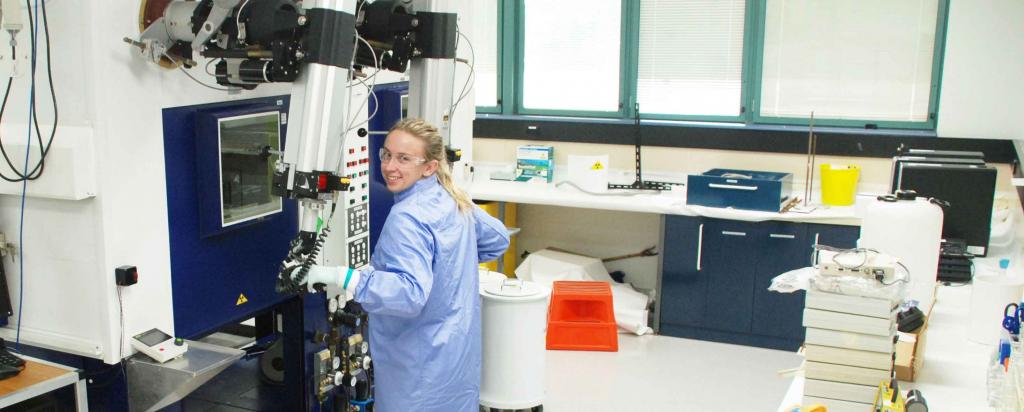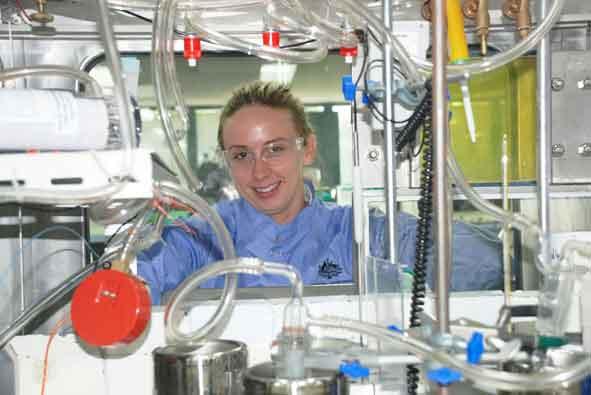

Published on the 4th February 2019 by ANSTO Staff

To coincide with World Cancer Day, ANSTO is pleased to announce that radiochemist Leena Hogan (pictured below) has been awarded the prestigious ‘Dr Joan R. Clark Research Scholarship’ from the University of Sydney.

As the recipient of the scholarship Hogan will be travelling in March 2019 to the world-renowned Memorial Sloan Kettering Cancer Centre (MSKCC) in New York. The seven week trip is supported by the University of Sydney and ANSTO, and Hogan will be working in the laboratories of eminent cancer researcher Prof Jason S. Lewis, the Emily Tow Jackson Chair in Oncology at MSKCC.
Prof Lewis develops radiopharmaceuticals for targeted diagnosis and treatment of cancer.
His laboratories specialise in using cutting-edge, non-standard radionuclides including zirconium-89, lutetium-177 and gallium-68. These radionuclides are attached to biological vectors (often small molecules, peptides or antibodies) and then evaluated in pre-clinical animal models to determine suitability for advancement to human clinical trials.
Using the best methods available to attach radionuclides to radiopharmaceuticals is critical to their work.
As part of her PhD studies at ANSTO and The University of Sydney, Hogan has been working on new ways to attach radionuclides, like gallium-68, to biological vectors to produce new radiopharmaceuticals.
“My work is aimed at improving the way we attach the radionuclide to the radiopharmaceutical. Our new method can potentially improve currently available radiopharmaceuticals by increasing their sensitivity for detecting tumours, increasing their brain uptake and decreasing radiation burden to patients”.
During her time at MSCKK Hogan will have access to world-class radiochemistry and pre-clinical PET imaging facilities.
These facilities will allow her to determine if the new ligand system – developed during her PhD – called ‘NOTET’ works better than ‘NOTA’ or ’DOTA’ which are the current gold standards for gallium-68 radiolabelling.
The highly efficient radiopharmaceutical development pipeline at MSKCC will allow Hogan to evaluate her ligands in 7 weeks, a task that could take 6-12 months at ANSTO.
“If NOTET proves better than NOTA or DOTA in a number of ways, including how well it holds onto the gallium-68, it could become the new gold standard for radiolabelling with gallium-68,” said Hogan.
Hogan explains that not only is NOTET designed to hold onto gallium-68 more strongly than NOTA or DOTA but it is predicted to be less ‘polar’ or form more lipophilic complexes with gallium-68.
This has tremendous potential applications as increased lipophilicity may allow the development “first in class” gallium-68 radiopharmaceuticals for diagnosing brain diseases.
“Currently almost all PET radiotracers for diagnosing brain diseases are based upon the radionuclide fluorine-18, but our ligand NOTET may open up this entire field to gallium-68.
Gallium-68 has the advantage over fluorine-18 that it can transported to hospitals in generators. This alleviates the need for local cyclotron production of the radioisotope and can save hospitals millions of dollars,” said Hogan.
Hogan went on to explain that another challenge in the design of ligands for gallium-68 radiopharmaceuticals is finding a temperature that efficiently allows radiolabelling but does not decompose the sensitive biological vector (small molecule, peptide or antibody).
“The potential great advantage of NOTET is that it can be radiolabelled under mild, room temperature conditions, and that these conditions are favourable for many sensitive biological vectors. We will be performing a side-by-side comparison of NOTET with NOTA / DOTA in neuroendocrine tumour animal models using gallium-68 DOTATATE. Hopefully we will demonstrate NOTET allows greater sensitivity for detecting tumours, radiolabelling at lower temperatures, and a decreased radiation burden to patients,” said Hogan.
Head of radiochemistry at ANSTO Dr Ivan Greguric has developed an ongoing, strong relationship with Prof Lewis and MSKCC.
Previous collaborative projects include the evaluation of a prototype ANSTO developed gallium-68 generator. Prof. Lewis has also participated in an ANSTO breakfast symposium on multi-modal imaging at the recent WFNMB2018 conference in Melbourne.
“This is great opportunity for Leena to work at a world-leading cancer research facility and experience, first-hand, clinical translation of basic research into first in human radiopharmaceutical trials,” said Greguric.
The results of the work undertaken at MSCKK will be included in Hogan’s PhD thesis and forthcoming scientific publications. Her PhD Is supervised by Emeritus Professor Trevor Hambly at the University of Sydney and ANSTO’s Dr Nigel Lengkeek.
The award is named in honour of the American chemist and former University of Sydney Fulbright scholar who pioneered early work in the field of x-ray crystallography. The award allows outstanding inorganic chemistry PhD students to study abroad at world class research institutes.
